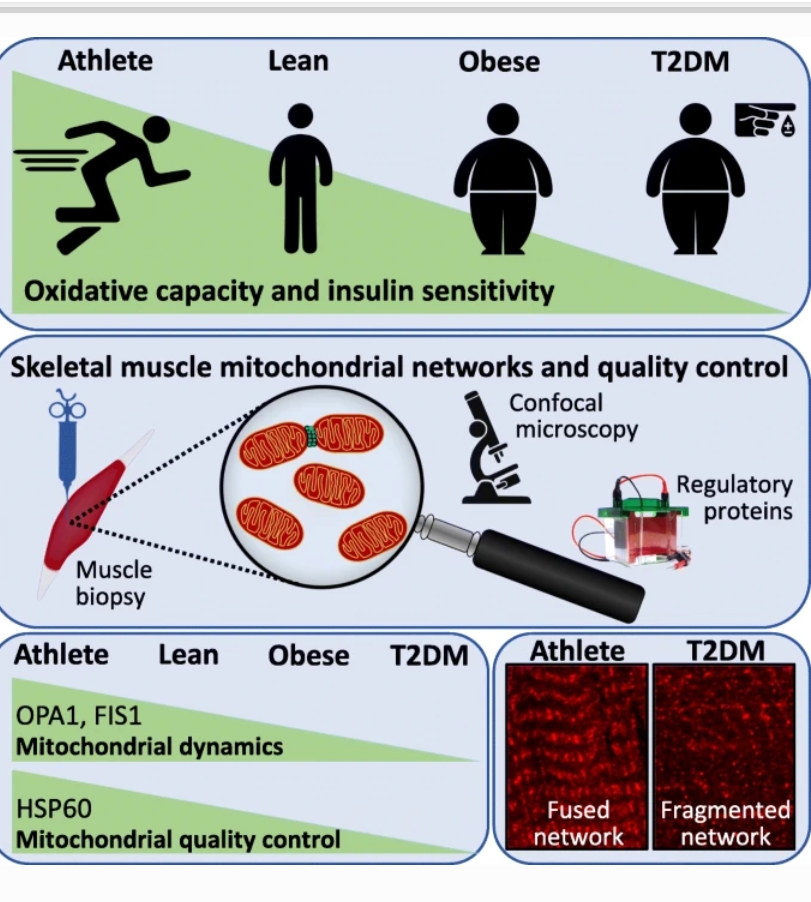Human skeletal muscle mitochondrial dynamics in relation to oxidative capacity and insulin sensitivity
Alexandre Houzelle, Diabetologia volume 64, pages424–436(2021)
Aims/hypothesis
Mitochondria operate in networks, adapting to external stresses and changes in cellular metabolic demand and are subject to various quality control mechanisms. On the basis of these traits, we here hypothesise that the regulation of mitochondrial networks in skeletal muscle is hampered in humans with compromised oxidative capacity and insulin sensitivity.
Methods
In a cross-sectional design, we compared four groups of participants (selected from previous studies) ranging in aerobic capacity and insulin sensitivity, i.e. participants with type 2 diabetes (n = 11), obese participants without diabetes (n = 12), lean individuals (n = 10) and endurance-trained athletes (n = 12); basal, overnight fasted muscle biopsies were newly analysed for the current study and we compared the levels of essential mitochondrial dynamics and quality control regulatory proteins in skeletal muscle tissue.
Results
Type 2 diabetes patients and obese participants were older than lean participants and athletes (58.6 ± 4.0 and 56.7 ± 7.2 vs 21.8 ± 2.5 and 25.1 ± 4.3 years, p < 0.001, respectively) and displayed a higher BMI (32.4 ± 3.7 and 31.0 ± 3.7 vs 22.1 ± 1.8 and 21.0 ± 1.5 kg/m2, p < 0.001, respectively) than lean individuals and endurance-trained athletes. Fission protein 1 (FIS1) and optic atrophy protein 1 (OPA1) protein content was highest in muscle from athletes and lowest in participants with type 2 diabetes and obesity, respectively (FIS1: 1.86 ± 0.79 vs 0.79 ± 0.51 AU, p = 0.002; and OPA1: 1.55 ± 0.64 vs 0.76 ± 0.52 AU, p = 0.014), which coincided with mitochondrial network fragmentation in individuals with type 2 diabetes, as assessed by confocal microscopy in a subset of type 2 diabetes patients vs endurance-trained athletes (n = 6). Furthermore, lean individuals and athletes displayed a mitonuclear protein balance that was different from obese participants and those with type 2 diabetes. Mitonuclear protein balance also associated with heat shock protein 60 (HSP60) protein levels, which were higher in athletes when compared with participants with obesity (p = 0.048) and type 2 diabetes (p = 0.002), indicative for activation of the mitochondrial unfolded protein response. Finally, OPA1, FIS1 and HSP60 correlated positively with aerobic capacity (r = 0.48, p = 0.0001; r = 0.55, p < 0.001 and r = 0.61, p < 0.0001, respectively) and insulin sensitivity (r = 0.40, p = 0.008; r = 0.44, p = 0.003 and r = 0.48, p = 0.001, respectively).
Conclusions/interpretation
Collectively, our data suggest that mitochondrial dynamics and quality control in skeletal muscle are linked to oxidative capacity in humans, which may play a role in the maintenance of muscle insulin sensitivity.














